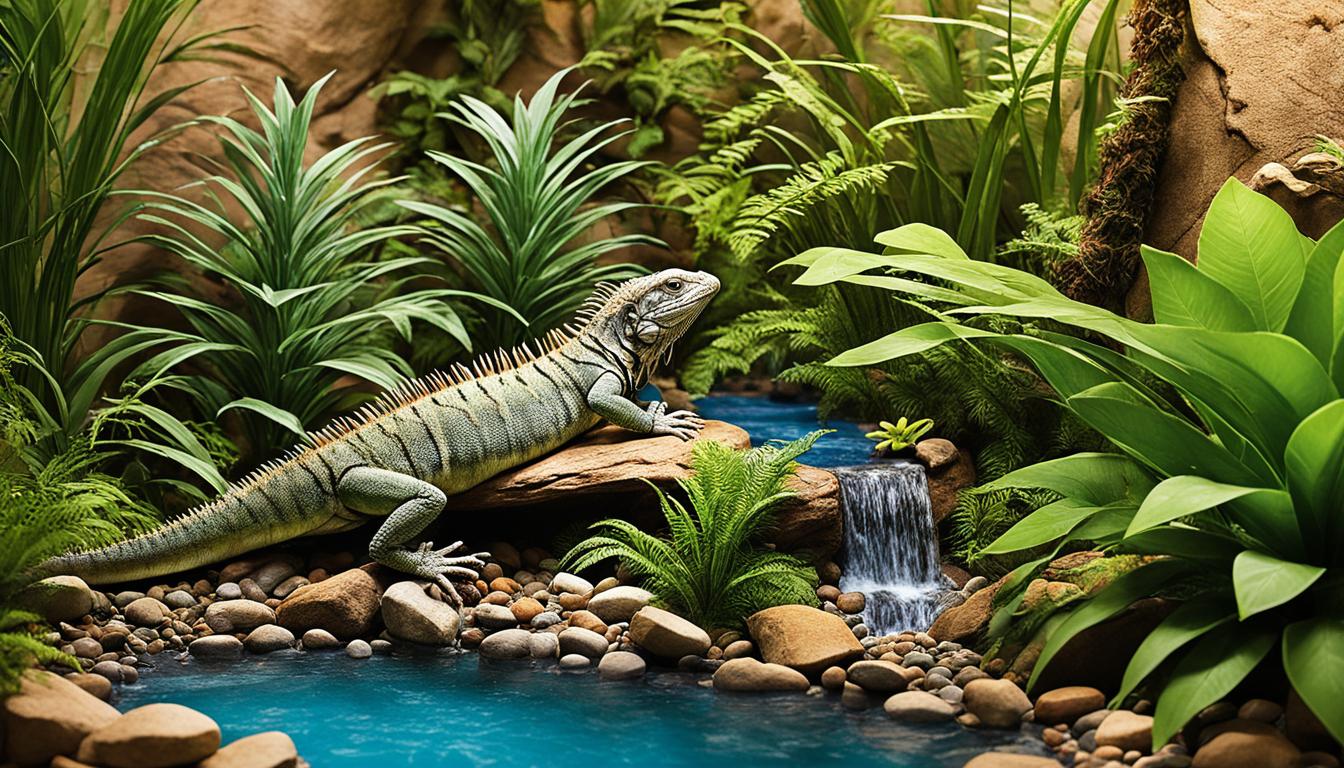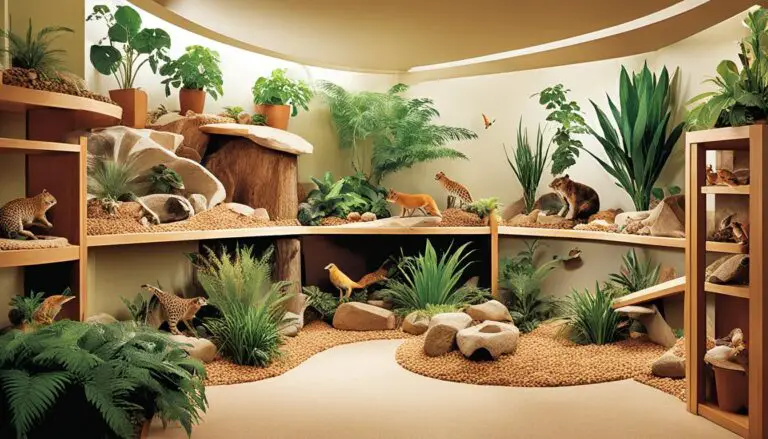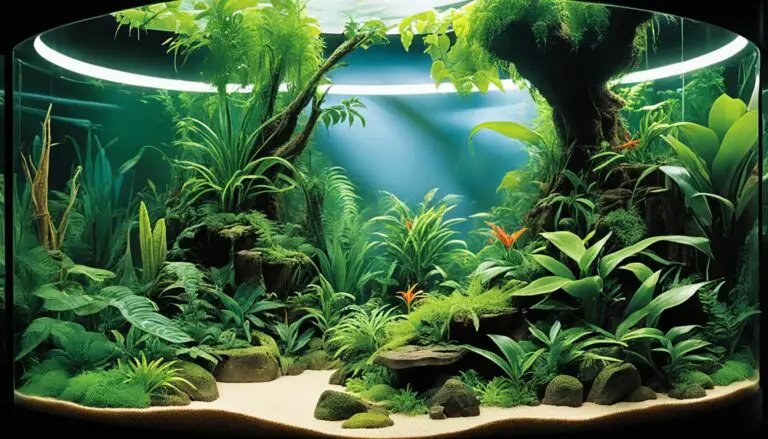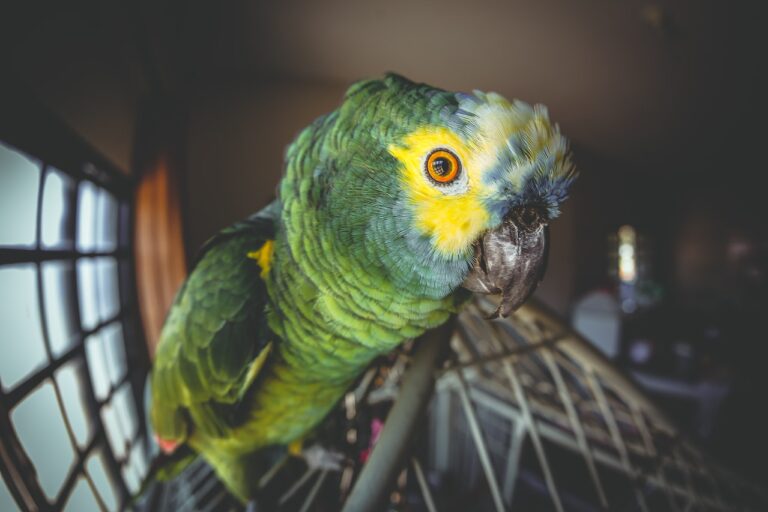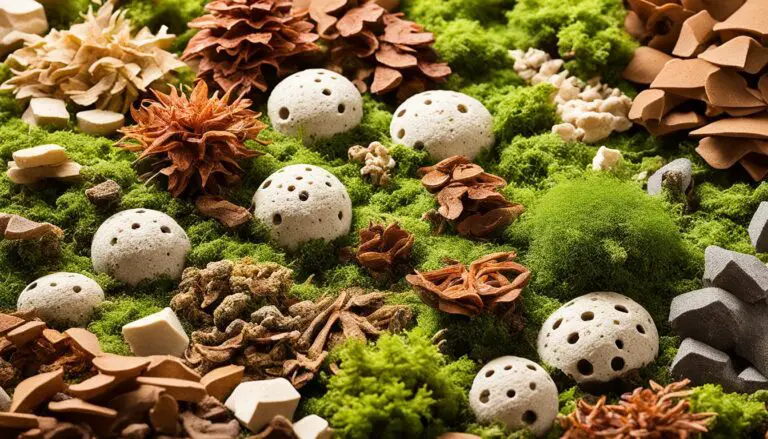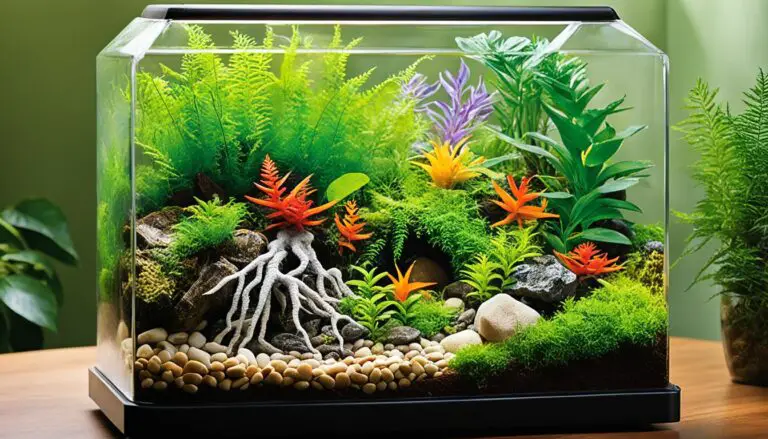Exotic Pet Housing Decor: Unique Ideas & Tips
Want to make a cozy and stylish space for your exotic pets? Explore creative ideas and suggestions for exotic pet housing decor. Learn how to create unique pet habitats, luxury pet enclosures, and premium animal dwellings. These should match your home’s style and keep your pets happy.
Key Takeaways:
- Create designated pet rooms or areas to provide a dedicated space for your pets.
- Design play and exploration areas that cater to your pet’s needs, such as cat trees, pet playpens, and natural-looking structures.
- Ensure your pet has a cozy sleeping area, with options like pet beds and heated sleeping spaces.
- Set up a pet feeding station with elevated bowls and nearby storage compartments for convenience.
- Choose non-toxic plants and create safe outdoor spaces, such as enclosed patios or outdoor enclosures.
Designate a Pet Room
Creating a pet-friendly home starts with setting aside a space for your pets. An extra bedroom or flex space works well for this. Even without a whole room, a corner or nook can become your pets’ spot.
This area can hold their food, toys, and cozy places to sleep. Add a cat tree or wall catwalks for cats. Dogs will like a dog bed and some chew toys. Birds enjoy perches, swings, and climbing areas. Reptiles or small animals can have a room with reptile cages for the right light and warmth.
Having a pet room keeps your home neat and free from pet mess. It gives them a spot for all their things. You can decorate it to reflect their personalities.
A pet room or corner makes a safe and comfy place for your pets. It also keeps your home looking good and functional for everyone.
Why Designate a Pet Room?
Designating a pet room provides your pets with their own space, keeping the rest of your home organized and free from pet-related clutter.
Incorporating Cat Trees and Dog Beds
For cats, you can incorporate a cat tree or catwalks on the walls. For dogs, a comfortable dog bed and chew toys can be included in their designated pet room.
Creating an Enriching Environment for Birds and Reptiles
Birds can have perches, swings, and small climbing structures in their designated room, while reptiles and small animals benefit from pet rooms with specialized reptile cages for better control of temperature and lighting.
Design for Play & Exploration
When setting up a place for your pets, make sure there’s lots of room for fun and discovery. A special pet play space lets them act on their natural instincts. Here are some ideas that are easy and not too pricey for your pet-friendly home:
- Add cushions to window seats: Cats and dogs enjoy watching the world outside. Adding comfy cushions to window seats creates a cozy spot for them to relax and watch.
- Install cat trees or catwalks: Cats love to climb because it’s in their nature. Cat trees or catwalks in living areas give them a place to climb and keep them entertained.
- Pet playpen with natural-looking structures: Small pets like bunnies or guinea pigs need a safe, fun play area. A pet playpen with natural-looking structures lets them hop and play happily.
- Tubes and tunnels: Ferrets, mice, and hamsters enjoy running through tunnels. Adding tubes and tunnels to their area helps them stay active and mentally alert.
Bird owners can create a bird playground or set up parrot perches. This lets birds fly freely in a safe space. It helps them stay active and safe while out of their cage.
Always focus on safety when making a play space for your pets. Think about what your pets like and need. Giving them chances to play and explore is good for their health. It also makes your bond with them stronger.
Create a Cozy Sleeping Area
Creating a cozy spot for your pets to sleep and relax is crucial. Invest in a comfortable pet bed that looks good in your home. This way, your pet has a special place to rest. Be sure the bed fits your pet’s size and sleep style.
Consider putting the pet bed in a quiet corner of your home. This area should be away from busy places to ensure peaceful sleep. If space is tight, think about using the area under a staircase for a cozy nook. Your pet will feel safe and relaxed there.
For colder months, offer your pet a heated sleeping spot. Pets with short fur or older ones appreciate extra warmth when it’s cold. A heated bed or insert is a good choice. In warm months, a cooling pad can keep your pet comfortable by lowering their body temperature.
A cozy sleeping area is key to your pet’s happiness and health. Pets, like people, need their own spot to relax and recharge. This makes for a joyful and well-rested pet.
Tips for creating a cozy sleeping area for your pet:
- Choose a pet bed that matches your home decor and provides sufficient space for your pet to stretch out comfortably.
- Place the bed in a designated corner or create an enclosed sleeping space for a cozy and secure environment.
- Consider using a heated sleeping area or a cooling pad to adjust your pet’s temperature according to the seasons.
- Ensure the sleeping area is quiet, away from high traffic areas, and provides a calming atmosphere for your pet to sleep and relax.
Create a Pet Feeding Station
Finding a convenient spot for your pets to eat is key. A pet feeding station helps make mealtime easy by keeping everything organized in one spot. Here are some tips for setting up the perfect spot for your furry friend:
Elevated Pet Bowls
Consider elevated bowls for your pet’s meals. They help with digestion and ease strain on your pet’s neck and back. Elevated bowls also help keep the eating area clean by reducing spills.
Storage Compartments
Add storage compartments to your pet feeding station for treats and food. You can build these into the station or place them nearby for easy access. This setup also keeps food out of sight, stopping pets from sneaking treats.
Under-the-Counter Refrigerator
If fresh food is your choice for your pet, think about an under-the-counter fridge just for them. It’s a safe spot to keep perishables apart from your food. A personal fridge for their meals will surely make your pet happy!
Setting up a pet feeding station means a special spot for dining that also keeps things neat. With features like elevated bowls, handy storage, and a fridge, your pet’s meal area will be both practical and suited to their needs.

Stick with Non-Toxic Plants
If you have pets, it’s important to think about the plants in your home. Some plants can be harmful to pets. Choosing pet-friendly plants keeps your home safe and healthy for them. Here are some non-toxic plants that look good and won’t hurt your pets:
- Spider plants: These plants clean the air and are safe for cats and dogs.
- Ponytail palms: They are easy to care for and safe for your pets.
- Prayer plants: Available in bright patterns, these plants are safe for homes with pets.
- Boston ferns: These ferns bring elegance to any room and don’t harm pets.
Talking to your vet or looking up information online can help. You have to make sure the plants you choose are safe for your pets. Even non-toxic plants can cause reactions in some pets, so watch how they act with new plants around.
“Choosing non-toxic plants not only helps keep your pets safe but also allows you to create a lush and green environment in your home without any worries.” – Veterinarian Jennifer Adams
Tips for Pet-Friendly Plant Care:
Looking after pet-friendly plants properly is key. Here are tips to make sure your plants and pets are both happy:
- Dust the leaves regularly to avoid dust and allergens.
- Keep plants away from pets so they can’t chew on them.
- Watch your pets for signs of plant poisoning like vomiting. Get vet help if needed.
- Water and fertilize plants as recommended for their health.
By choosing the right plants and caring for them well, you can make your home beautiful and safe for your pets.
**Table: Top Pet-Friendly Houseplants**
PlantPet-Friendly RatingSpider PlantSafe for cats and dogsPonytail PalmNon-toxic to petsPrayer PlantSafe for cats and dogsBoston FernNon-toxic to pets
Source: American Veterinary Association
Create a Pet Patio
If you want your pets to enjoy the outdoors safely, think about making an enclosed patio or catio. It’s a special area where your cat can have fun outside but stay safe. Dogs can have a space to run and play, too.
And for pets like reptiles or small animals, you can build outdoor enclosures. Just make sure it’s secure and right for your pet.
An enclosed patio or catio is great for keeping your pets safe outdoors. They’re protected from things like traffic and bad weather. It gives them a chance to play and act naturally outside.
Catios offer cats a fun place to climb and watch the world. Add things like shelves and cat trees for them to explore. Don’t forget a comfy spot for them to rest and enjoy the breeze.
Dogs need a big space to run and play in. Create a dog patio that lets them move freely. Add their favorite toys and maybe a spot for digging.
For exotic pets, outdoor enclosures allow them to enjoy nature under your watch. Create the right setting for them, considering temperature and safety.
Safety should be your main focus. Build the enclosure with strong materials and check it often. Watch out for things that could harm your pets.
With an enclosed patio or catio, your pets can experience nature safely. It’s a great way to make their lives better. Be creative to ensure it meets your pet’s needs.

Conclusion
Making your home pet-friendly doesn’t mean you have to give up style or function. With the right planning and creative design, your place can look great and be cozy for your pets too. You can have areas just for your pets, fun spots to play, comfy places to sleep, spots for eating, and furniture that’s easy on your pets.
Don’t forget about your pet’s safety. Choose plants that won’t hurt them and make sure they have fun, safe places to explore outside. By keeping these tips in mind, you can make a space that looks good to you and is great for your pets as well.
So let your imagination run wild and start making your home more welcoming for your pets. By focusing on design and functionality, you and your pets can enjoy a home that’s both stylish and pet-friendly.
FAQ
What is the first step in creating a pet-friendly home?
What can I include in a pet room?
How can I create a play area for my pets?
What should I consider when creating a sleeping area for my pets?
How can I create a pet feeding station?
What kind of houseplants are safe for pets?
How can I create an outdoor space for my pets?
Source Links
- https://www.extraspace.com/blog/home-organization/barkitecture-ideas-for-a-pet-centric-home/
- https://www.zoocreatures.com/pet-habitat-enclosure-decor/
- https://www.linkedin.com/pulse/pawsome-interiors-designing-pet-friendly-paradise-your-furry
Peter Stones is the founder of Exotic Pets Place, the leading online resource for exotic pet care information.
With over 10 years of hands-on exotic pet ownership experience, he is deeply passionate about sharing his expertise to help others properly care for their unusual pets.
When he's not writing extensively researched articles or connecting with fellow exotic pet enthusiasts worldwide, you can find Peter at home tending to his own beloved menagerie of exotic animals.

